- 20,685
- TenEightyOne
- TenEightyOne
I posted this because of the remarks NASA made about it.
Got a link?
I posted this because of the remarks NASA made about it.
Looks like somebody's angling for a free Peugeot.
I saw this on a recorded replay of NASA's Unexplained Files, first aired 4/19/2017, on the SCIHD cable channel. The episode was called "Curse of the Gas Giant".Got a link?


It looks like it could be a gun turret from an alien siege spacecraft or, if that scale is too grand and this is indeed significantly smaller, maybe it's the fossilized remains of the infamous tube-anused tortoise of Titan.You have a picture of a rock.
They have a policy of avoiding anything or anywhere that might be connected to present or past life due to the problem of contamination.
It's for the landers. So they won't contaminate potential signs of life with Earthly germs and bacteria.Source for this policy in their Mars program and not just for returning orbiters?
It's for the landers. So they won't contaminate potential signs of life with Earthly germs and bacteria.


Home About Overview Categories Policy News Events Documents Requirements Design Mars Missions History Course Links Glossary


all of the planets, all of the time
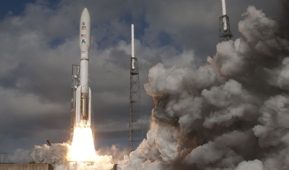
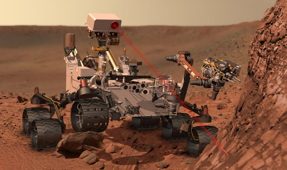
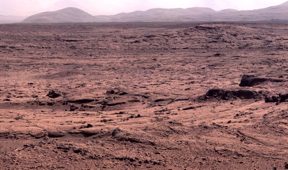

FAQS
About the Office
Mission Categories I-V
Annotated Requirements
List of Missions
COSPAR PP Panel
Contact NASA PPO
About the Office
Overview
News
Events
Documents
Mission Categories
Solar System Bodies
List of Missions
Mission Design & Planning
Mission Requirements
Mars Requirements
International Policy
Workshops in Planetary Protection
History of Planetary Protection
Course in Planetary Protection
Glossary of Terms
Contacts
Links
Overview
What is Planetary Protection?
Planetary protection is the term given to the practice of protecting solar system bodies (i.e., planets, moons, comets, and asteroids) from contamination by Earth life, and protecting Earth from possible life forms that may be returned from other solar system bodies.
- What is Planetary Protection and Why is it Important? (video)
- Overview of Planetary Protection (video)
- Brief Overview on Returning Samples from Mars and International Guidelines (video)
Why is Planetary Protection Important?
Planetary protection is essential for several important reasons: to preserve our ability to study other worlds as they exist in their natural states; to avoid contamination that would obscure our ability to find life elsewhere — if it exists; and to ensure that we take prudent precautions to protect Earth’s biosphere in case it does. Typically, planetary protection is divided into two major components: forward contamination, which refers to the biological contamination of explored solar system bodies; and backward contamination, which refers to the biological contamination of Earth as a result of returned extraterrestrial samples.
NASA Planetary Protection Policy
NASA maintains a planetary protection policy that is defined by the NASA Policy Directive (NPD) 8020.7G: Biological Contamination Control for Outbound and Inbound Planetary Spacecraft. In turn, the NASA Office of Planetary Protection administers associated procedures to ensure compliance with NPD 8020.7G using the guidelines and requirements described in the NASA Procedural Requirements (NPR) 8020.12D: Planetary Protection Provisions for Robotic Extraterrestrial Missions. As described in the following section, the NASA policy, and its associated guidelines and requirements, are well aligned with the COSPAR Planetary Protection Policy, and is consistent with Article IX of the ‘Outer Space Treaty’. More information is provided in the history of planetary protection and international policy pages of this site. NASA’s Planetary Protection Officer oversees compliance with formal implementation requirements that are assigned to each mission, and is typically directly involved in the development and planning stages of solar system missions. More information on the requirements is provided below, and a summary of the planetary protection mission categories, planetary protection requirements, and methods & implementation used to ensure compliance with NASA policy are found on the respective pages of this site. In accordance with the NASA policy, requirements are based on the most current scientific information available about the target bodies and about life on Earth. The Planetary Protection Officer requests recommendations on implementation requirements for missions to a specific solar system body, or class of bodies, from internal and external advisory committees (for example, the National Advisory Council Planetary Protection Subcommittee); but most notably from the Space Studies Board of the National Research Council. In recent years the Space Studies Board has provided recommendations on planetary protection requirements for Mars, Europa, and sample return missions from a variety of small solar system bodies such as moons, comets, and asteroids. Many of the Space Studies Board reports are posted on the Documents page. Recommendations from the Space Studies Board are routinely reassessed as new information becomes available.
International Treaties and Organizations with Cognizance of Planetary Protection Activities
Agreements regarding planetary protection stem from the 1967 United Nations Treaty on Principles Governing the Activities of States in the Exploration and Use of Outer Space, Including the Moon and Other Bodies, which states that all countries party to the treaty “shall pursue studies of outer space, including the moon and other celestial bodies, and conduct exploration of them so as to avoid their harmful contamination.” Internationally, technical aspects of planetary protection are developed through deliberations by the Committee on Space Research (COSPAR), part of the International Council of Science (ICSU), which consults with the United Nations in this area. The COSPAR Panel on Planetary Protectiondevelops and makes recommendations on planetary protection policy to COSPAR, which may adopt them as part of the official COSPAR Planetary Protection Policy. More information on the history of planetary protection and international policy is provided on the respective pages of this site.
Requirements for Protecting Life on Other Bodies
Planetary protection requirements for each mission and target body are determined based on the scientific advice of the Space Studies Board and on NASA or international policy guidelines. Each mission is categorized according to the type of mission (e.g., flyby, orbiter, or lander), the nature of its destination (e.g., a planet, moon, comet, or asteroid), and the planetary bodies that may be encountered during the mission (e.g., Mars and Europa). The corresponding requirements are, in turn, formalized and developed in consultation with the Planetary Protection Officer. In general, if the target body has the potential to provide clues about life or prebiotic chemical evolution, a spacecraft going there must meet a higher level of cleanliness, and some operating restrictions will be imposed. If non-target bodies of interest to life or prebiotic chemical evolution may be encountered during mission, the spacecraft may also be required to meet a higher level of cleanliness, and some operating restrictions may be imposed. Spacecraft traveling to target bodies with the potential to support Earth life must undergo stringent cleaning and sterilization processes, and greater operating restrictions. Further information can be obtained from the following pages:
The first Martian landers, Vikings 1 and 2, which launched in 1975, were the cleanest things that NASA has ever sent into space. After their final bake-off at Kennedy Space Center (two hundred and thirty-three degrees Fahrenheit for thirty hours), they were determined to have just 0.3 organisms remaining—not an actual tally, of course, but the result of an abstract calculation that took into account the results of pre-assembly surface swabs and average kill rates. When the Viking data came back from Mars, it painted a picture of a much harsher, drier environment than many planetary scientists had hoped or imagined, and subsequent missions were accordingly allowed to carry a higher bioburden. The Mars Science Laboratory—the mission that landed the Curiosity Rover in August, 2012—was estimated to host just under thirty thousand heat-resistant bacterial endospores at launch, many more than Viking, but, as Conley pointed out, “still fewer than the number on your hand.”
As NASA scientists have learned more about both the Martian climate and the extreme hardiness of some Earth microbes, however, they have had to update their risk assessments. “The idea was that we need to be the most vigilant on the early missions, when we don’t have any knowledge of Mars, and we can relax when we know more,” Conley said. “But it turns out maybe we relaxed too much.” When she conducted the planetary-protection review of Curiosity’s proposed landing site, at Gale Crater, she thought, “This is a flat site at the equator. There’s no way it will have water.” Following last week’s announcement, however, it now seems that there may be water only a few miles away from Curiosity’s path. Under current COSPAR rules, the rover is not clean enough to go near it. “Mars continues to surprise us,” Conley said. “This is a good problem to have.” To solve it, she is consulting her advisory committee, an eclectic group of geologists, astrobiologists, planetary scientists, representatives from other government departments and foreign space agencies, a lawyer, a communications expert, and—this spot is currently vacant—an ethicist.
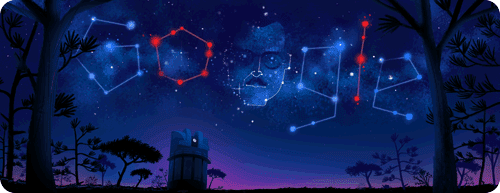
https://www.vox.com/2018/3/21/17144988/google-doodle-guillermo-haro-birthday-105-astronomer-orionGuillermo Haro spotted supernovae and flare stars in the night sky
The Mexican astronomer identified the mysterious jets of gas in the Orion nebula.
By Umair Irfan Updated Mar 21, 2018, 7:56am EDT
Guillermo Haro, who was the first to discover several nebulae, flare stars, and supernovae in the cosmos, is honored in today’s Google Doodle on what would have been his 105th birthday.
snippet:
-----------------------------------
-----------------------------------
From his perch at the Tonantzintla Observatory in Puebla, Mexico, he observed jets of gases ejected at hundreds of miles per second from newborn stars forming clouds in space. These formations are now known as Herbig-Haro objects; Haro shares credit with George Herbig, who identified them on his own.
Haro also scoured the sky around the Orion Nebula in the Orion constellation, finding red and blue flare stars, small stars that surge unpredictably with brightness. He identified the Haro-Chavira Comet as well.
----------------------------------
----------------------------------
M'kay... source?
Correction on this, apparently the May 5th launch is NOT a Falcon 9 but an Atlas V. I swear the schedule changed and it was a F9 before. Either way, my next opportunity to go to a F9 launch would have been April 28th but I was supposed to be out of town that week for a work trip. Found out yesterday that the trip was moved up so now I can attend that launch. So that is the plan.So hoping to make a trip to Vandenberg AFB for the May 5th Falcon 9 launch. Did a little research and got a good place to watch located which I guess is like 4 miles from the launch pad. Just hope it's not postponed or scrubbed the morning of. It's also at 7:20am (as of right now) so I'm not sure if I want to get a hotel in LA and make the drive up there super early that morning, or just get a hotel nearby.
I'd also like to catch a Falcon Heavy launch towards the end of the year but flying to Florida only to have it scrubbed would be a huge bummer.
I mean...I read it as a playful jab or perhaps a continuation of the trend not unlike when a small child plays the "why" game--in other words, not to be taken seriously.Do you just have trouble trusting him or what?
I mean...I read it as a playful jab or perhaps a continuation of the trend not unlike when a small child plays the "why" game--in other words, not to be taken seriously.
Do you just have trouble trusting him or what? Considering Dotini does sometimes go on a very unorthodox and albeit paranormal rant and spewing of info, he also has the tendency to post up actual useful info on space science.
He also has a tendency to produce stuff from dubious sources as fact or present his wholly arbitrary opinions as fact. I don't think it's unreasonable to ask anyone for an actual source on scientific research or policy, and that goes double for people who have been less than reliable in the past.
Which is why I find it a bit goofy while at the same time acceptable, even though dotini's claims weren't all that off the wall.
In this case the claims were solidly on the wall, but it's still interesting to see. I mean, there's a legitimate trade off to be made on the odds of detecting life (which seem fairly remote at this stage) versus more deeply examining areas which we already have prior knowledge of. Locking yourself out of that is unusual.
I find it odd that it's actually a policy for Mars landers; certainly they attempt to avoid transporting any living species to Mars accidentally but not overlapping landers is not protecting Mars from "contamination", all it's doing is increasing the confidence of any scientific results that point towards native Martian life. I would have thought that it would be a guideline, unless you have reason you should avoid previous landing sites but it wouldn't be a hard and fast requirement if you were attempting to further study an area. Any results from a site that has had multiple landings would take that into consideration before pushing out the "Marvin the Martian Discovered On Mars" headlines.
But NASA is getting pretty bureaucratic these days, so I'm not that surprised that someone managed to make that into a rule.
I'm even willing to make a bigger leap and accept not wanting to introduce any alien material, biological or otherwise, to an environment being studied as it may affect the context of any discoveries made, whether they be evidence of life or anything else.I dont, it is similar to wanting to keep an area undisturbed here on earth that has ancient history with in it. I find the rovers as much scientific in effort to find life, as they are a potential archaeological exploration if signs of advanced ancient life is found.
I'm even willing to make a bigger leap and accept not wanting to introduce any alien material, biological or otherwise, to an environment being studied as it may affect the context of any discoveries made, whether they be evidence of life or anything else.

"We noticed this perfect arc developing across the sky," says Greenhill. "It didn't seem like the aurora since it wasn't moving much. The arc got brighter and then faded and then got brighter again. And then it dawned on me, this is STEVE!"
STEVE is an aurora-like phenomenon that researchers are only beginning to understand. For many years, northern sky watchers reported the form occasionally dancing alongside auroras. It was widely called a "proton arc" until researchers pointed out that protons had nothing to do with it. So members of the Alberta Aurora Chasers group gave it a new name: "Steve" (since upgraded to STEVE, an acronym for 'Strong Thermal Emission Velocity Enhancement').
The first clues to the nature of STEVE came in 2016 when one of the European Space Agency's Swarm satellites encountered the phenomenon. "As the satellite flew straight though 'Steve,' the temperature jumped by 3000°C and the data revealed a 25 km-wide ribbon of gas flowing westwards at about 6 km/s (13,000 mph)," reports Eric Donovan from the University of Calgary.
This ESA animation shows Swarm satellites orbiting Earth above ground cameras observing STEVE
Donovan and a team of colleagues led by Elizabeth MacDonald of NASA's Goddard Space Flight Center have just published a paper on STEVE. In it, they confirm that STEVE is distinct from ordinary auroras, usually forming to the south of active Northern Lights. The mauve and purple colored arcs, they say, are related to supersonic rivers of gas called "subauroral ion drifts" (SAIDs), which flow through Earth's magnetic field. Earth-orbiting satelites have tracked thousands of SAIDs: they tend to appear near latitude +60 degrees, and occur more frequently during spring and fall than summer and winter.
This last point means that now is the season for STEVE. The onset of northern spring seems to lure the arc out of winter hiding.
"I saw STEVE for the first time on March 18th," reports Giuseppe Petricca , who took this sequence of pictures from the Isle of Lewis in Scotland:

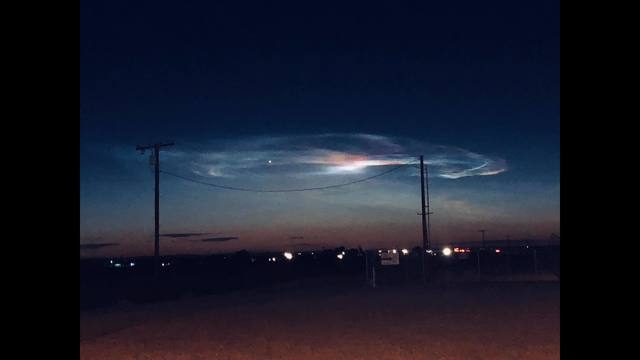
 That's the bad part with rocket launches, they're never set in stone until the countdown hits zero and it jumps off the pad. I'd love to go to Florida in June for the next Falcon Heavy launch but planning around that could be a nightmare.
That's the bad part with rocket launches, they're never set in stone until the countdown hits zero and it jumps off the pad. I'd love to go to Florida in June for the next Falcon Heavy launch but planning around that could be a nightmare.  Iridium-5 Mission by Official SpaceX Photos, on Flickr
Iridium-5 Mission by Official SpaceX Photos, on FlickrUnfortunately the launch from the same location on April 28th was delayed so I will not be watching a launch while I am in the area that weekend.
